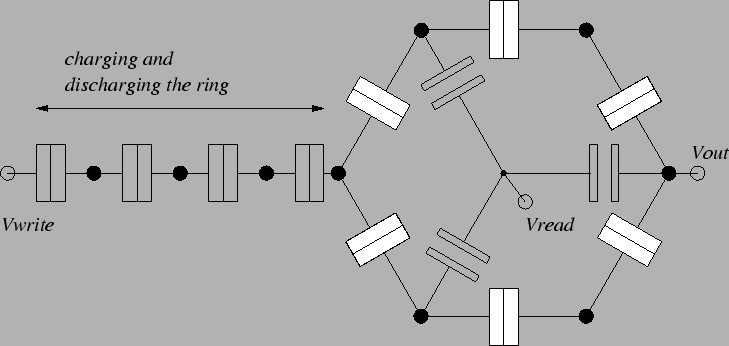



Next: 5.2.9 Qo Independent Memory
Up: 5.2 Single Electron Memories
Previous: 5.2.7 Multi Tunnel Junction
5.2.8 Ring Memory
We are proposing an idea which is a generalization of the bistable quantum
cell for cellular automata by C. Lent et al. [75]. On the circuit level
it is also similar to the MTJ memory, because it is
a multiple tunnel junction connected to a ring, which is why we call it a ring
memory cell (see Fig. 5.10).
Figure 5.10:
Circuit diagram of the ring memory cell.
 |
An even number n (in our case n=6) of tunnel junctions are connected
to a ring, and n/2 electrons are inserted into the ring.
These electrons will repel each
other and can form two stable configurations (see Fig. 5.10
left side). Applying voltage pulses on
 or
or
 will switch the state of the ring to either one of the
stable configurations. The capacitors C0 should be small compared to the
capacitances of the tunnel junctions, so that the electrons have a large
influence on their neighbors and keep their distance.
will switch the state of the ring to either one of the
stable configurations. The capacitors C0 should be small compared to the
capacitances of the tunnel junctions, so that the electrons have a large
influence on their neighbors and keep their distance.
A more complex memory cell, but with considerably improved characteristics
is a combination of a ring memory and a MTJ memory, as shown in
Fig. 5.11.
Figure 5.11:
Circuit diagram of a ring trap memory combination.
 |
The idea is to load and empty a ring memory over
a MTJ. Further the two stable states of the ring memory are not used to
distinguish between logic zero and one, but to move trapped charges around
by applying a sequence of pulses to
 ,
which produce Coulomb oscillations in an adjacent SET transistor. If no electrons are
trapped in the ring no current oscillations will be induced in the
SET transistor. This memory cell is random background charge independent,
since only the presence and absence of Coulomb oscillations distinguishes between logic zero
and one. The basic idea of using Coulomb oscillations to achieve random background charge
independence was taken from the memory explained next in
Section 5.2.9. However our ring-trap memory has a
non-destructive read cycle, which comes at the cost of a higher
circuit complexity.
,
which produce Coulomb oscillations in an adjacent SET transistor. If no electrons are
trapped in the ring no current oscillations will be induced in the
SET transistor. This memory cell is random background charge independent,
since only the presence and absence of Coulomb oscillations distinguishes between logic zero
and one. The basic idea of using Coulomb oscillations to achieve random background charge
independence was taken from the memory explained next in
Section 5.2.9. However our ring-trap memory has a
non-destructive read cycle, which comes at the cost of a higher
circuit complexity.




Next: 5.2.9 Qo Independent Memory
Up: 5.2 Single Electron Memories
Previous: 5.2.7 Multi Tunnel Junction
Christoph Wasshuber
